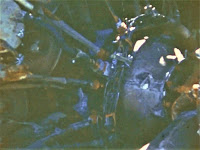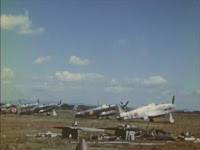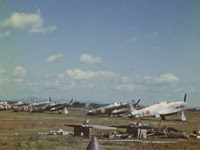Let's wrap up this month with a most interesting NARA video, found in the "Showakan Digital Archive"; here.
The video was spotted by "Shu" who has a Twitter page, HERE, that you should not fail to visit!
The video was spotted by "Shu" who has a Twitter page, HERE, that you should not fail to visit!
Let's see some stills.
First of all, at the end of the video, the information plate says it was shot in "Saga" on October 12, 1945.
Actually, the location is Metabaru airfield, in Saga Prefecture.
The first aircraft that come into view are a heavily damaged Nakajima B6N "Tenzan" (Jill) and a very badly damaged different kind of aircraft.
The tail marking of the "Jill" is visible in this and a following still and it's "131-75", indicating that this aircraft belonged to the 131 Kokutai. It looks as though the first "1" is in white. A curiosity.
For more about the 131 Kokutai, check here.
In the background, we can see a Mitsubishi G4M2 "Betty" and it seems to have its' tail number overpainted and deleted.
Moving on, the cameraman spent some time shooting the cockpit and the instrument panel of a Zero.
Then turned his attention to a destroyed Yokosuka K5Y "Akatonbo" (Willow).
Interesting detail: the trainer has its fuselage undersurfaces also camouflaged in green. Note also the colour of the propeller. Not wood. But how about the big aircraft behind it with the fuselage windows?
In this still, we can clearly see the rest of the "Tenzan" tail number, in yellow, and a better view of the big wrecked aircraft.
It's a Fokker Super Universal!!! or maybe a Nakajima-built C2N.WOW!
This cowling/prop is a bit confusing. The three blades suggest a Nakajima C6N "Saiun" but the short spinner suggests a "Tenzan". It maybe got shortened due to damage?
How about this engine.
Any ideas?
Moving on, it's time to examine the IJAAF fighters, starting with dozens of Kawasaki Ki-61 "Hien" (Tonys) lined up.
The silver aircraft on the right seems to have one or two white fuselage bands and the rudder seems to be in green. Alternatively, could it be there is no white stripe(s) but the camo is roughly applied until the fuselage side hinomaru?
Note also, that the third "Hien" from the right definitely has a diagonal thin white (?) stripe behind the cockpit and that the fourth has the tail marking in white instead of red. The differences in the red of the fuselage hinomaru is worth mentioning too.
In the next two photos, the tail marking is more clearly visible; "Shu" believes the "Hien" belonged to the 11th Rensei Hikotai (Fighter Operational Training Unit) and I agree.
Below is a photo from the "244 Sentai" page by Sakurai-san, from here, featuring a Ki-61 of the 11th taking off on a tokko mission from Metabaru in 1945.
Note the yellow (?) diagonal line crossing the hinomaru and the number "32" (?) above the tail marking.The unit tail marking has been depicted by Nohara Shigeru in FAOW#17.
The unit was organized on November 30, 1944, in Metabaru. The commander of this little-known unit was Major Yamaguchi Sakae.
Let's take a closer look at the fore section of the "Hien".
We can clearly see the difference in the colours and patterns of the props and the spinners. Notice also the small yellow stripes near the tip of the prop blade.
The clip ends with two views of Nakajima Ki-43 Model 3 "Hayabusa" (Oscars).
The first is a colour version...
...of this NARA photo.
A closeup on the tail of the aircraft in the foreground reveals the remains of a tail marking of a previous unit; Akeno?
Note also the marking in red...
...and the small Shinto shrine in the background.
The also little-known unit was organized on August 1, 1938, initially as a light bomber unit equipped with Nakajima Ki-4 Reconnaissance and Mitsubishi Ki-2 Light Bombers. A year later changed to Mitsubishi Ki-32 "Mary". After the beginning of the Pacific War, it changed again to Mitsubishi Ki-51 "Sonia" and was active in China mainland. On October 1944, took part in the battle of the Philippines, suffered heavy losses and was forced to return to Hokota in Ibaraki Prefecture. Then relocated to Haranomachi airfield where it changed to "Hayabusa" Model 3 and became a fighter bomber unit. In April 1945, moved first to Metabaru and then to Chiran in Kyushu to take part in the Battle of Okinawa. While there, some sources mention that it organized a tokko unit (or units) and conducted night attacks against ships, losing 27 pilots. On July 11, 1945, the remaining members and aircraft returned to Metabaru and prepared for the battle of Japan's mainland where the war's end found them.
Nohara Shigeru has depicted the unit's aircraft in Model Art #395 as such.
Note the colour of the drop tank and the IFF stripe.
A few details about Metabaru.
We found a document in JACAR describing all the aircraft found in Metabaru in September 1945.
The numbers in the "type" column refer to the Ki numbers (ex. Ki-43). It mentions 31 "Hayabusa" and 33 "Hien" which we can assume they belonged to the 65Sentai and the 11Rensei Hikotai respectively. Of particular interest is the single Ki-109! Unfortunately, it doesn't describe the types of the IJNAF aircraft.
Below is a map of the airfield and the surrounding area at the time.
And in this Japanese blog, we can see more details about the airfield's past and present.
Actually, in Metabaru there is a JIETAI base, here.



























2 comments:
George this is a great video. So much thats interesting. The green of the Tenzan, the prop of the K5Y, the line up of Hein I'm still looking at it. Thank you for showing this to us.
Fascinating and oh-so-very informative !!!
Thanks to George and "Mr. Shu"
Post a Comment